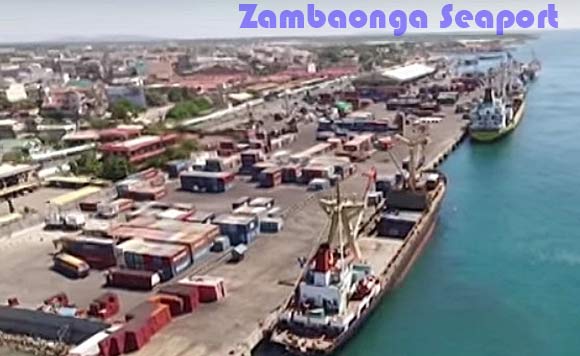The Port of Zamboanga is a seaport located in Zamboanga City located in western Mindanao. The international container Port of Zamboanga ranked 2nd in Asia according to the 2010 Super Efficient Ports in Asia study (African Journal of Business Management Vol. 5(4), pp. 1397-1407, 2011). Zamboanga City is the commercial and industrial center of the Zamboanga Peninsula, which faces the Basilan Strait to the north, and the Moro Gulf and Sulu Sea to the south. In 2015, Zamboanga City ranked 3rd in infrastructure, 15th in Government Efficiency, 26th in Economic Dynamism, for an overall raking of 15th in National Competitiveness.
The Port of Zamboanga is a center for sardine exports to the United States, Europe, the Middle East, and the Far East. There are 25 shipping lines that operate via the port, serviced by 4 shipyards operating within the port and Zamboanga City. The port has a land area of 15.6 hectares. The Seaport of Zamboanga has 19 docks, 12 of which are privately owned. The largest dock has capacity for up to 20 vessels, and is operated by the Philippine Ports Authority (PPA).
As of end-September (3rd quarter) 2018, passenger and cargo transport continue to be the major port industries of Zamboanga.
Total Passenger traffic in the Port of Zamboanga exceeded 3.8 million, surpassing the ports of Misamis Occidental 2.7M, Lanao del Norte/Iligan at 2.3M, Misamis Oriental/CDO at 2.2M, Surigao at 2.1M, Marinduque at 1.5M, and Manila at 1.1M passengers.
The Port of Zamboanga’s total Cargo throughput of 2.6 million MT, comprised 86% domestic cargo and 14% foreign cargo; with 75% of operations largely at Baseport (Non-Roro). Its cargo throughput surpassed Lanao del Norte at 2.2M; Bicol at 1.8M; Eastern Leyte/Samar at 1.7M; Misamis Occidental at 1.1M; Zamboanga del Norte at 0.8M; Mindoro at 0.5M; and Masbate at 0.4M MT.
Total Shipcalls in the Port of Zamboanga were mainly domestic, and reached 12,746 shipcalls, lower than Eastern Leyte/Samar at 15,930; Western Leyte/Biliran at 13,210; but higher than Misamis Oriental/CDO at 12,595 shipcalls.
With 8 Reefers and 6,200 sqm paved storage complementing facilities, the Port of Zamboanga’s total Container cargo ships reached 77,535 TEUs, which were purely domestic ships, and surpassed Palawan at 59,927 TEUs; Eastern Leyte/Samar at 39,875; Agusan at 38,800; Negros Oriental/Siquijor at 32,308; Misamis Occidental at 32,176; Bohol at 27,711 TEUs, Lanao del Norte/Iligan at 10,544; Bicol at 5,963 TEUs; Surigao at 4,157 TEUs, and Masbate at 3,554 TEUs.
With 2 RORO ramps and a Finger Pier with a RORO platform, the Port of Zamboanga’s RORO cargo exceeded 129,000 units, which were mostly type 1 cargo from the Baseport and OTP Isabela. Its RORO cargo is higher than Bohol at 120,510; Zamboanga del Norte at 74,957; Masbate at 58,074; Agusan at 8,811; Manila North Harbor at 1,139; and Palawan at 1,116 RORO cargo units.
In 2107, with 6 major berthing areas with drafts ranging between 6-13 meters, the Port of Zamboanga’s total Gross Registered Tonnage exceeded 8.9 million GT, the volume of all enclosed spaces of ships that had docked last year.
Philippine 2GO Ferries have one ferry a week sailing to & from Manila to Zamboanga City via Dipolog and Dumaguete. The Port of Zamboanga, an international port of entry, also features Aleson Shipping Lines, a scheduled passenger ferry going to & from Sandakan, Malaysia. A shipping cargo company from Vietnam also services the route to & from Zamboanga City. Departing passengers are well accommodated in a spacious terminal building. Terminal 1 covers 620 sqm while Terminal 2 covers 960 sqm. The Port of Zamboanga not only handles inter-island and international fast ferries, but on occasion, international cruise ships as well.
The Port of Zamboanga is considered the shipping hub of western Mindanao. Its 5,400 sqm container yard is large enough to handle 20 ft and 45 ft containers; with a 4,320 sqm container freight station to load & unload containerized cargo. It has a paved marshalling yard covering 13,700 sqm where the containers can be arranged and stacked in sequence. Local drayage capacity to pull containers out of the port to load or unload is more than sufficient, and the port is the beginning & ending terminal of the Pan-Philippines National Highway, allowing delivery of goods to any port in the country. The Port of Zamboanga employs stevedoring laborers who are skilled, and ample in number.
In the pipeline are two expansion reclamation projects, covering 7,291 sqm and 12,958 sqm, as back-up storage areas, which were about 25% complete as of January this year.
On 26-November-2018, PMO Zamboanga inaugurated its Port One-Stop-Shop (POSS). PMO Zamboanga, led by Port Manager Liberto C. Dela Rosa, inaugurated its POSS designed to facilitate various transactions at the port in compliance with RA 11032, the Act of Promoting Ease of Doing Business and Efficient Delivery of Government Services.
The POSS, the first of its kind under the PPA, is aimed to streamline all port operation transactions and pool together concerned or attached government agencies under a single roof to optimize efficiency.
The POSS hosts key agency partners such as the Philippine Coast Guard (PCG), Maritime Industry Authority (MARINA), Bureau of Animal Industry, Bureau of Plant Industry, Bureau of Quarantine, ZC Integrated Ports Services Inc, and Shipping Line Operators.
